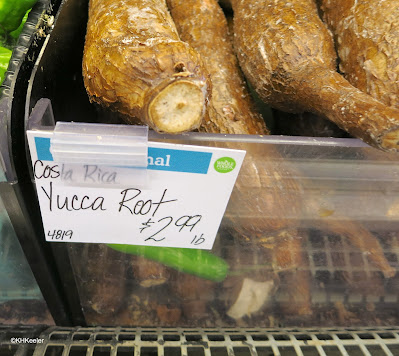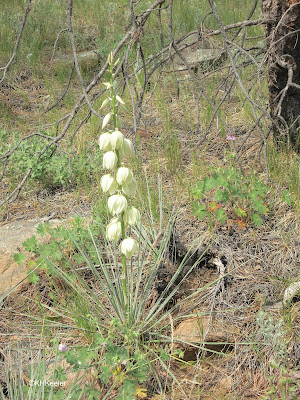Yucca and yuca are different plants. Both are important plants, but they don't grow in the Eastern U.S., rarely show up in grocery stores, and aren't in bouquets of flowers, so many people don't know them. And, therefore, don't know to try not to confuse them.
 |
| Yuca roots labeled as yucca. |
Yucca is a genus of plants native from western North America south into Central America, in the agave family, Agavaceae. They have sword-like leaves (long, tapering to a point, and very sharp at the tip) that grow in a cluster. The plant sends up flower stalks with large white flowers. There are about 40 species of Yucca, 28 in the United States, some relatively small, some tree-like (the Joshua tree is Yucca brevifolia). Yucca is the scientific name. Their common names include Spanish bayonet, Spanish dagger, dagger plant, palmella, Adam's needle, beargrass, needle palm, silkgrass, soapweed, and Joshua tree, but lazy botanists long ago just said yucca, turning the scientific name into a common name. Many of the lesser-known species have unimaginative common names like plains yucca, Mojave yucca, and Arkansas yucca.
 |
| yucca in New Mexico |
Yuca is the name, in the Carib language, for the plant also called cassava, manioc, and tapioca, genus Manihot (spurge family, Euphorbiaceae). Yuca, Manihot esculenta, was the major starch in the diet of the peoples tropical America for more than 4,000 years. Today, it is grown around the world and is an even more important food crop. Yuca is a woody shrub that grows 6-10 feet tall with leaves bigger than your hand that look rather hand-like. (Search on Manihot esculenta to see leaf photos, I don't have one better than in the photo below.)
Yuca forms starchy tubers on the roots. Originally, yuca was very toxic, roots and all, containing moderate to large amounts of the cyanogenic (cyanide-producing) glycosides linamarin and lotaustralin. These compounds readily react to become forms of hydrogen cyanide, in concentrations strong enough to be fatal to adults. People of the American tropics shredded the roots and pressed out the liquid, then let it sit at least overnight. Hydrogen cyanide is volatile so it steadily escaped from the shredded roots into the air. The resultant mass could be fried as flatbread (frying removed any remaining hydrogen cyanide) or ground into flour. We marvel at the human ingenuity involved; how did they learn to process the poisonous yuca roots? Why did they think to try?
 |
| Yuca, Manihot esculenta, roots. The leaf is a yuca leaf. |
Tapioca is made from yuca starch mixed with boiling water. That causes the starch to jell into the translucent pellets we call tapioca.
Grown throughout the American tropics, local races of yuca with a lower concentration of cyanogenic glycosides evolved centuries ago. Called "sweet yuca" these plants dominated the yucas that, starting in the early 16th century, were introduced around the world. Today they feed millions of people in tropical regions, especially in Africa. Sweet yuca cannot with any certainty be told from bitter yuca (those with large amounts of cyanogenic glycosides), so in the Americas, any yuca is prepared as if it were bitter yuca.
 |
| Yuca roots for sale, lightly waxed to extend shelf-life. |
In sum: yucca is an agave relative of western North and Central America; yuca is the spurge called cassava, manioc, and tapioca.
The name confusion goes back 350 years. The Swede, Carolus Linnaeus (1707-1778) created the system of two-part scientific names we use today. He named all the plants and animals he could find. Presented with a flattened, dried yucca plant to name, he confused it with yuca and gave it the scientific name, Yucca. If we called yuccas Spanish bayonets or soapweeds, there'd be no confusion, but since we use the scientific name as the common name, people confuse yucca and yuca.
Yuca and yucca come together in Texas and Florida and the states in between. Several of the 100 species of Manihot are native in the southernmost United States, and yuca, Manihot esculenta, is planted there as an ornamental or vegetable. Likewise, many species of yucca can be found there, both wild and cultivated.
No part of yuca should be eaten without preparation and only the roots are treated and consumed. Yucca roots are too soapy and too fibrous to be edible, but the flowers can be tasty. Be sure you know the difference!
|
Comments and corrections welcome.
References
Flora of North America Editorial Committee, eds. 1993+. "Yucca Linnaeus"; "Manihot Crantz." Flora of North America North of Mexico [Online]. 22+ vols. New York and Oxford. http://beta.floranorthamerica.org. Accessed [7/25/21].
Simpson, B. B., and M. C, Orgazaly. 2014. Plants in Our World. 4th ed. McGraw Hill Education, New York.
Smartt, J. and N. W. Simmonds. 1995. Evolution of Crop Plants. 2nd ed. Longman Scientific, London.
Kathy Keeler, A Wandering Botanist
More at awanderingbotanist.com
Join me on Facebook: https://www.facebook.com/AWanderingBotanist


Yucca plants are… YUCK!
ReplyDeleteThat’s how I’m remembering the difference.